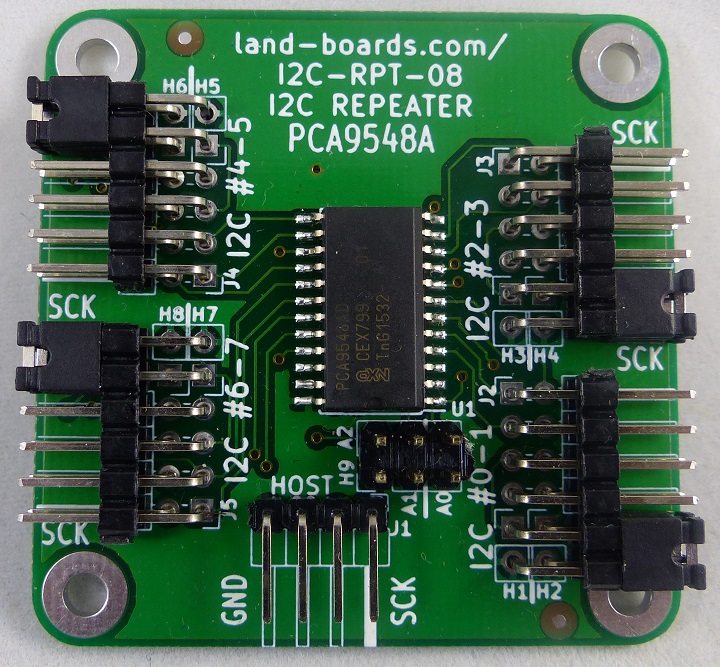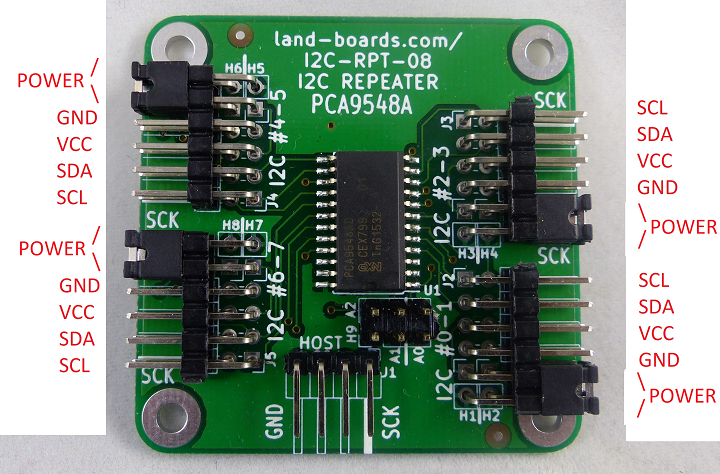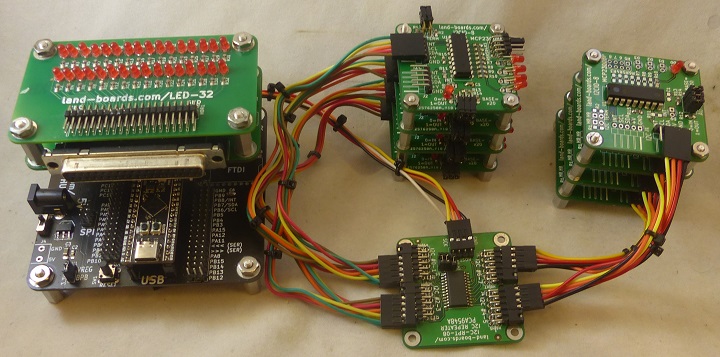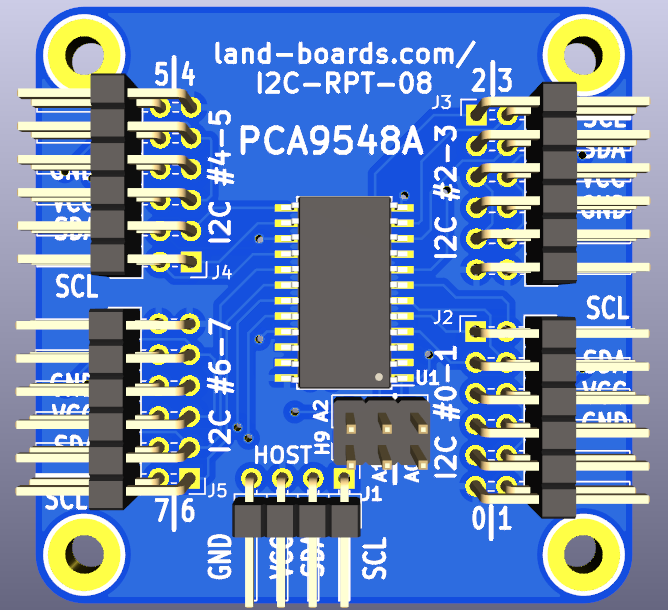Difference between revisions of "I2C-RPT-08"
Jump to navigation
Jump to search
Blwikiadmin (talk | contribs) |
Blwikiadmin (talk | contribs) |
||
| (58 intermediate revisions by the same user not shown) | |||
| Line 1: | Line 1: | ||
| − | [[File:tindie-mediums.png|link=https://www.tindie.com/products/ | + | [[File:tindie-mediums.png|link=https://www.tindie.com/products/9603/]] |
| + | |||
| + | [[File:I2C-RPT-08-X1-P218-720px.jpg]] | ||
<video type="youtube">npC48tq4MF8</video> | <video type="youtube">npC48tq4MF8</video> | ||
| − | |||
| − | |||
== Features == | == Features == | ||
| − | * I2C Hub / Repeater / Replicator / Multiplexer / De-multiplexer | + | * I2C Hub / Repeater / Replicator / Multiplexer / De-multiplexer / Switch |
| − | ** [https://www.nxp.com/docs/en/data-sheet/PCA9548A.pdf PCA9548A] | + | ** [https://www.nxp.com/docs/en/data-sheet/PCA9548A.pdf PCA9548A Datasheet] |
** Eight I2C Ports | ** Eight I2C Ports | ||
** 100KHz/400KHz operation | ** 100KHz/400KHz operation | ||
| + | ** I2C Base Address 0x70 | ||
| + | *** Offset addresses 0x70-0x77 | ||
* Host port | * Host port | ||
** Controlled via I2C | ** Controlled via I2C | ||
** 3.3V or 5V host operation | ** 3.3V or 5V host operation | ||
| + | ** Can power slave cards if they are at the same voltage | ||
* 3.3V or 5V slave ports operation | * 3.3V or 5V slave ports operation | ||
| + | ** Removable jumper(s) to supply power from slave | ||
* Voltage translation between the ports | * Voltage translation between the ports | ||
| − | * Ex: a Raspberry | + | ** Ex: a Raspberry Pi which runs 3.3V can control I2C devices which run at 5V |
| − | * On-board termination resistors | + | * On-board 2.2K termination resistors |
* 49x49mm form factor | * 49x49mm form factor | ||
* 4 solid 4-40 mounting holes | * 4 solid 4-40 mounting holes | ||
| + | * Drivers/Example Code | ||
| + | ** Arduino driver and example code | ||
| + | ** Raspberry Pi example code | ||
== Connectors == | == Connectors == | ||
| − | * The connectors are 2x6 right angle 0.1" pitch headers | + | * 0.1" pitch connections |
| + | * [https://www.ebay.com/sch/i.html?_from=R40&_trksid=p2380057.m570.l1313.TR2.TRC1.A0.H0.Xdupont+header.TRS0&_nkw=dupont+header&_sacat=0 Search ebay for Dupont headers] | ||
| + | * [https://www.ebay.com/sch/i.html?_from=R40&_trksid=p2334524.m570.l1311.R4.TR4.TRC1.A0.H0.Xdupont+jumper.TRS0&_nkw=dupont+wire+jumper+cable&_sacat=0&LH_TitleDesc=0&_osacat=0&_odkw=arduino+cable Search ebay for Dupontwire jumper cable] | ||
| + | * The slave I2C connectors are (4) 2x6 right angle 0.1" pitch headers | ||
| + | * Two ports per 2x6 connector | ||
* Two of the pins are for power to or from the I2C connector | * Two of the pins are for power to or from the I2C connector | ||
* The other four pins are for the I2C interface | * The other four pins are for the I2C interface | ||
| + | |||
| + | [[File:I2C-RPT-08-X1-Conns-P218-720px.png]] | ||
=== H1-H8 - Power to/from I2C Connectors === | === H1-H8 - Power to/from I2C Connectors === | ||
| Line 31: | Line 44: | ||
* Install shunt to power the I2C slave card from the I2C-RPT-08 Card | * Install shunt to power the I2C slave card from the I2C-RPT-08 Card | ||
** Default factory ships as installed to power external I2C interfaces from the card | ** Default factory ships as installed to power external I2C interfaces from the card | ||
| + | * Remove shunt to power interface externally | ||
| + | ** Need to remove if external voltage is different level or sourced externally | ||
| + | * H1 - PORT #0 | ||
| + | * ... | ||
| + | * H8 = PORT #7 | ||
| + | |||
| + | === H9 - I2C Slave Address Jumpers === | ||
| + | |||
| + | * A0-A2 | ||
| + | * Install all 3 jumpers for address 0x70 | ||
| + | * Remove all three jumpers for address 0x77 | ||
| − | === I2C | + | === J1 - Host I2C Connection === |
| − | # | + | # GND (GND pin marked) |
| − | # VCC (Power Out - if jumper 1-2 installed, Power in - if jumper 1-2 is not installed) | + | # 3.3V or 5V VCC |
| + | # SDA | ||
| + | # SCL | ||
| + | |||
| + | === J2-J5 - Slave I2C Connections (x8) === | ||
| + | |||
| + | # GND | ||
| + | # 3.3V or 5V VCC (Power Out - if jumper 1-2 installed, Power in - if jumper 1-2 is not installed) | ||
# SDA | # SDA | ||
# SCL (Board marked with SCK) | # SCL (Board marked with SCK) | ||
| + | |||
| + | == Jumpers == | ||
| + | |||
| + | === A0-A2 - Multiplexer I2C Base Address === | ||
| + | |||
| + | * Install for Ax = 0 (factory default address = 0) | ||
| + | * Remove for Ax = 1 | ||
== Schematic == | == Schematic == | ||
| − | * [http://land-boards.com/I2C-RPT-08/I2CRPT08_RevX1_Schematic.pdf I2C-RPT-08 Schematic] | + | * [http://land-boards.com/I2C-RPT-08/I2CRPT08_RevX1_Schematic.pdf I2C-RPT-08 Rev X1 Schematic] |
| + | * [http://land-boards.com/I2C-RPT-08/I2CRPT08_Rev2_Schematic.pdf I2C-RPT-08 Rev 2 Schematic] | ||
== Drivers/Example Code == | == Drivers/Example Code == | ||
| − | * [https://github.com/land-boards/lb-Arduino-Code/tree/master/libraries/LandBoards_I2CRPT08 Github repo | + | * [https://github.com/land-boards/lb-Arduino-Code/tree/master/libraries/LandBoards_I2CRPT08 Arduino Driver code] - Github repo |
| − | * [https://github.com/land-boards/lb-Arduino-Code/blob/master/LBCards/I2CRPT08/I2CIO8X8wMux/I2CIO8X8wMux.ino Github repo] - | + | * [https://github.com/land-boards/lb-Arduino-Code/blob/master/LBCards/I2CRPT08/I2CIO8X8wMux/I2CIO8X8wMux.ino Arduino Example code] - Github repo |
| + | * [https://github.com/land-boards/RasPi/tree/master/RPI-I2C-Hub Raspberry Pi Example Code] - Github repo | ||
=== Programming Note === | === Programming Note === | ||
| Line 52: | Line 92: | ||
* The mux chip allows multiple or single I2C ports to be written at the same time | * The mux chip allows multiple or single I2C ports to be written at the same time | ||
** To only enable one port at a time make sure you disable a channel after use or disable last channel used before enabling new channel | ** To only enable one port at a time make sure you disable a channel after use or disable last channel used before enabling new channel | ||
| + | |||
| + | === Arduino Driver Functions === | ||
| + | <pre> | ||
| + | LandBoards_I2CRPT08(void) - Constructor | ||
| + | void begin(uint8_t addr) - Set mux I2C address (offset or absolution 0x70-0x77) | ||
| + | void begin() - Assume I2C address = 0x20 | ||
| + | void setI2CChannel(uint8_t chNum, uint8_t enableFlag) - chNum = 0x0-0x7. I2CRPT08_MUXCH_DISABLE, I2CRPT08_MUXCH_ENABLE | ||
| + | uint8_t getI2CChannel(void) - Read entire channel status - useful for testing | ||
| + | </pre> | ||
== Testing == | == Testing == | ||
| + | |||
| + | === Test Station Hardware === | ||
| + | |||
| + | [[File:IC2RPT-08_P1871-720px.jpg]] | ||
* [[Arduino Based Test Station]] | * [[Arduino Based Test Station]] | ||
| − | ** | + | ** Built in I2C mux on [[BLACK-PILL-HUB]] is set to offset=0x1 so it does not conflict with I2C address of UUT |
| + | ** Cabling | ||
| + | *** UUT J1 Host connects to I2C port (J7) on the [[BLACK-PILL-HUB]] | ||
* Uses 8x of [[I2CIO-8]] cards | * Uses 8x of [[I2CIO-8]] cards | ||
| − | * On UUT | + | ** Cabling 4 wire from [[I2CIO-8]] cards J1 to UUT I2C #0-#7 |
| − | ** Install jumpers into A0-A2 | + | ** Address jumpers are all installed for base address of 0x20 |
| − | *** I2C | + | * On Unit Under Test (UUT) |
| − | *** | + | ** Install (3) h9 jumpers into A0-A2 for card I2C address = 0x70 |
| − | * | + | |
| + | === Test Procedure === | ||
| + | |||
| + | * Run puTTY | ||
| + | ** COM port from Device Manager | ||
| + | ** 9600 baud | ||
| + | ** No parity | ||
| + | ** No handshake | ||
| + | * Menu will display | ||
| + | <pre> | ||
| + | Checking if EEPROM is present on UUT...EEPROM is not present on UUT | ||
| + | Count of I2C devices in range 0x20-0x27 on UUT = 0 | ||
| + | Found external I2C mux card | ||
| + | Select I2C Mux board type | ||
| + | 1 - I2C-RPT-01 board | ||
| + | 2 - I2C-RPT-08 board | ||
| + | </pre> | ||
| + | * Enter 2 | ||
| + | * Replies with | ||
| + | <pre> | ||
| + | Init I2C-RPT-08 card | ||
| + | I2CIO8 card #0 was detected | ||
| + | I2CIO8 card #1 was detected | ||
| + | I2CIO8 card #2 was detected | ||
| + | I2CIO8 card #3 was detected | ||
| + | I2CIO8 card #4 was detected | ||
| + | I2CIO8 card #5 was detected | ||
| + | I2CIO8 card #6 was detected | ||
| + | I2CIO8 card #7 was detected | ||
| + | C=Card Tests, D=Direct, E=EEPROM, I=access Internal DIGIO32 | ||
| + | </pre> | ||
| + | * Verify that all 8 I2CIO-8 cards were detected | ||
| + | |||
| + | === Internal Tests === | ||
| + | |||
| + | * Select C to test card | ||
| + | * Select I to run internal tests | ||
| + | ** Tests I2C interface to UUT | ||
| + | <pre> | ||
| + | UUT Internal card tests | ||
| + | Test PASS = 1, FAIL = 0 | ||
| + | </pre> | ||
| + | |||
| + | === Bounce LEDS === | ||
| + | |||
| + | * Select B to bounce LED across LEDs on all 4 I2CIO-8 cards | ||
| + | * Verify all 16 LEDs blink | ||
| + | <pre> | ||
| + | Bounce a bit across outputs | ||
| + | Bouncing LEDs I2C-RPT-01 and I2CIO8 - any key to stop | ||
| + | Hit any key to stop test | ||
| + | </pre> | ||
| + | * Hit any key to stop blinking | ||
| + | |||
| + | === Test Station Software === | ||
| + | |||
* [https://github.com/land-boards/lb-Arduino-Code/tree/master/LBCards/ODAS/ODASTESTER ODAS Tester Github Repo] | * [https://github.com/land-boards/lb-Arduino-Code/tree/master/LBCards/ODAS/ODASTESTER ODAS Tester Github Repo] | ||
| − | + | == Issues == | |
| + | |||
| + | === Rev 2 === | ||
| − | == Issues == | + | * Rev 2 fixes SCK -> SCL |
| + | * Adds port numbers to slave connectors | ||
| + | * Move SMT fiducials to bottom (lot of resistors on the rear of card) | ||
| + | * Combined Power jumpers into the Port jumpers | ||
| + | * Moved J2 away from mounting screw | ||
| + | * Add silkscreen details | ||
| + | * Removed C2 from front of board | ||
| + | * Added 3D model for all parts | ||
| + | * KiCad 6 | ||
| + | |||
| + | [[file:I2C-RPT-08_FRONT.png]] | ||
| + | |||
| + | === Rev 1 Issues === | ||
| + | * No functional issues | ||
* Silkscreen shows SCK, should be SCL | * Silkscreen shows SCK, should be SCL | ||
== Assembly Sheet == | == Assembly Sheet == | ||
| − | * [[I2C-RPT-08 Assembly Sheet]] | + | * [[I2C-RPT-08 Assembly Sheet]] - Rev X1 |
| + | * [[I2C-RPT-08 Rev 2 Assembly Sheet]] - Rev 2 | ||
Latest revision as of 21:04, 15 May 2022
Contents
Features
- I2C Hub / Repeater / Replicator / Multiplexer / De-multiplexer / Switch
- PCA9548A Datasheet
- Eight I2C Ports
- 100KHz/400KHz operation
- I2C Base Address 0x70
- Offset addresses 0x70-0x77
- Host port
- Controlled via I2C
- 3.3V or 5V host operation
- Can power slave cards if they are at the same voltage
- 3.3V or 5V slave ports operation
- Removable jumper(s) to supply power from slave
- Voltage translation between the ports
- Ex: a Raspberry Pi which runs 3.3V can control I2C devices which run at 5V
- On-board 2.2K termination resistors
- 49x49mm form factor
- 4 solid 4-40 mounting holes
- Drivers/Example Code
- Arduino driver and example code
- Raspberry Pi example code
Connectors
- 0.1" pitch connections
- Search ebay for Dupont headers
- Search ebay for Dupontwire jumper cable
- The slave I2C connectors are (4) 2x6 right angle 0.1" pitch headers
- Two ports per 2x6 connector
- Two of the pins are for power to or from the I2C connector
- The other four pins are for the I2C interface
H1-H8 - Power to/from I2C Connectors
- Install shunt to power the I2C slave card from the I2C-RPT-08 Card
- Default factory ships as installed to power external I2C interfaces from the card
- Remove shunt to power interface externally
- Need to remove if external voltage is different level or sourced externally
- H1 - PORT #0
- ...
- H8 = PORT #7
H9 - I2C Slave Address Jumpers
- A0-A2
- Install all 3 jumpers for address 0x70
- Remove all three jumpers for address 0x77
J1 - Host I2C Connection
- GND (GND pin marked)
- 3.3V or 5V VCC
- SDA
- SCL
J2-J5 - Slave I2C Connections (x8)
- GND
- 3.3V or 5V VCC (Power Out - if jumper 1-2 installed, Power in - if jumper 1-2 is not installed)
- SDA
- SCL (Board marked with SCK)
Jumpers
A0-A2 - Multiplexer I2C Base Address
- Install for Ax = 0 (factory default address = 0)
- Remove for Ax = 1
Schematic
Drivers/Example Code
- Arduino Driver code - Github repo
- Arduino Example code - Github repo
- Raspberry Pi Example Code - Github repo
Programming Note
- The mux chip allows multiple or single I2C ports to be written at the same time
- To only enable one port at a time make sure you disable a channel after use or disable last channel used before enabling new channel
Arduino Driver Functions
LandBoards_I2CRPT08(void) - Constructor void begin(uint8_t addr) - Set mux I2C address (offset or absolution 0x70-0x77) void begin() - Assume I2C address = 0x20 void setI2CChannel(uint8_t chNum, uint8_t enableFlag) - chNum = 0x0-0x7. I2CRPT08_MUXCH_DISABLE, I2CRPT08_MUXCH_ENABLE uint8_t getI2CChannel(void) - Read entire channel status - useful for testing
Testing
Test Station Hardware
- Arduino Based Test Station
- Built in I2C mux on BLACK-PILL-HUB is set to offset=0x1 so it does not conflict with I2C address of UUT
- Cabling
- UUT J1 Host connects to I2C port (J7) on the BLACK-PILL-HUB
- Uses 8x of I2CIO-8 cards
- Cabling 4 wire from I2CIO-8 cards J1 to UUT I2C #0-#7
- Address jumpers are all installed for base address of 0x20
- On Unit Under Test (UUT)
- Install (3) h9 jumpers into A0-A2 for card I2C address = 0x70
Test Procedure
- Run puTTY
- COM port from Device Manager
- 9600 baud
- No parity
- No handshake
- Menu will display
Checking if EEPROM is present on UUT...EEPROM is not present on UUT Count of I2C devices in range 0x20-0x27 on UUT = 0 Found external I2C mux card Select I2C Mux board type 1 - I2C-RPT-01 board 2 - I2C-RPT-08 board
- Enter 2
- Replies with
Init I2C-RPT-08 card I2CIO8 card #0 was detected I2CIO8 card #1 was detected I2CIO8 card #2 was detected I2CIO8 card #3 was detected I2CIO8 card #4 was detected I2CIO8 card #5 was detected I2CIO8 card #6 was detected I2CIO8 card #7 was detected C=Card Tests, D=Direct, E=EEPROM, I=access Internal DIGIO32
- Verify that all 8 I2CIO-8 cards were detected
Internal Tests
- Select C to test card
- Select I to run internal tests
- Tests I2C interface to UUT
UUT Internal card tests Test PASS = 1, FAIL = 0
Bounce LEDS
- Select B to bounce LED across LEDs on all 4 I2CIO-8 cards
- Verify all 16 LEDs blink
Bounce a bit across outputs Bouncing LEDs I2C-RPT-01 and I2CIO8 - any key to stop Hit any key to stop test
- Hit any key to stop blinking
Test Station Software
Issues
Rev 2
- Rev 2 fixes SCK -> SCL
- Adds port numbers to slave connectors
- Move SMT fiducials to bottom (lot of resistors on the rear of card)
- Combined Power jumpers into the Port jumpers
- Moved J2 away from mounting screw
- Add silkscreen details
- Removed C2 from front of board
- Added 3D model for all parts
- KiCad 6
Rev 1 Issues
- No functional issues
- Silkscreen shows SCK, should be SCL
Assembly Sheet
- I2C-RPT-08 Assembly Sheet - Rev X1
- I2C-RPT-08 Rev 2 Assembly Sheet - Rev 2




